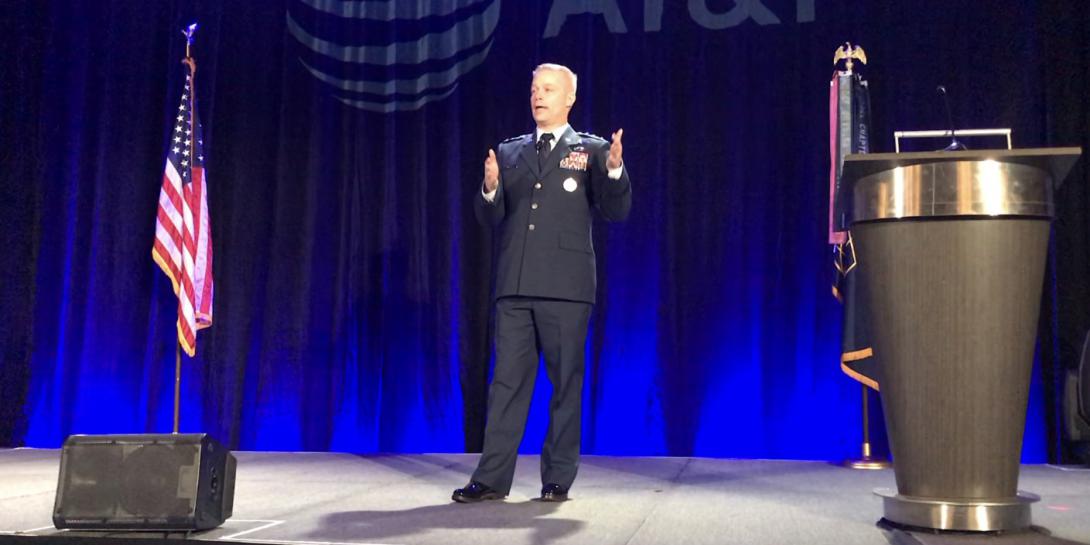16th Air Force Adjusts to Operating During COVID-19
The U.S. Air Force’s new information warfare Numbered Air Force (NAF), the 16th Air Force, stood up in October, reached full operating capability yesterday, reported its commander, Lt. Gen. Timothy Haugh, USAF. The 16th Air Force (Air Forces Cyber), which includes 10 wings, is the center of the Air Force’s cyber operations; intelligence, surveillance and reconnaissance (ISR) capabilities; electronic warfare and information operations. Since its inception last fall, the 16th Air Force, located at Joint Base San Antonio-Lackland (JBSA-L), has focused on integrating all of these capabilities, said Gen. Haugh.
The general spoke at the AFCEA Alamo Chapter’s monthly luncheon on April 21, held virtually due to the COVID-19 pandemic. Understandably, in response to the COVID-19 crisis, the 16th Air Force has had to initially refocus its priorities, the general explained. The NAF is juggling how to create a safe work environment while sustaining core mission efforts. The NAF had to tackle its telework capacity, quickly scaling up to support hundreds of thousands for airmen working remotely, while enabling the operation and defense of all the networks of the Air Force and the U.S. Space Force.
“It’s really been an impressive response from our airmen,” Gen. Haugh stated. “The priorities we set were really in line with the SECDEF [Secretary of Defense], Secretary of the Air Force, and commander of the ACC [Air Combat Command], with the first priority being the safety and health of our airmen and their families.”
At the same time, the 16th Air Force is executing it core Defense Department missions. “We’ve been very deliberate to make sure that we have scoped and scaled those missions to be the highest priority things that have to get done, so that we can keep a balance between mission execution, safety, health of our force, so that we never compromise the health and safety of the force as we execute the missions,” the general noted. “And we’ve gotten a lot done even through this most unique operating environment.”
The NAF provides intelligence to the service, a sustaining priority, even under the COVID-19 crisis, the general said. “[We looked at] what intelligence do we have to provide to the air components and the combatant commands to ensure they are operating in a safe and effective manner and that they have the information they need to ensure they are not surprised by an adversary,” he said. “We have done that expertly across our ISR wings and across our forward-deployed flying units. We’ve worked that with other services, with the National Security Agency, with other agencies to make sure it is balanced.”
In addition, as the Air Force component to the U.S. Cyber Command, the NAF has to make sure that it is meeting the command’s cyber requirements as defined by its commander, Gen. Paul Nakasone, USA. “We have to sustain operations to ensure that we can meet the highest priority tasks,” Gen. Haugh said.
Part of the support to Cyber Command is centered squarely on election defense. Gen. Nakasone has assigned the NAF “multiple roles” as part of the broader U.S. interagency election security effort, including helping to shed light on any adversary intentions.
Gen. Haugh reported that the NAF successfully executed a global integrated exercise that engaged all of the U.S. combatant commands. The NAF already provides information warfare support to several of the combatant commands, including the U.S. European Command, U.S. Transportation Command and U.S. Strategic Command, but the examination was a more comprehensive look, the general stated.
“It really tested in many ways how we approach being a global organization, from both an intelligence perspective as well as the role we play in networks and in cyber,” he noted. “It was a really good test of how we operate as a component with the other service cyber components across U.S. Cyber Command, as well as with number of the Combatant Commands that we are in support of, and we learned a number of lessons on how to operate in that global environment. You can see the potential that is coming from the synergy across our missions.”
With the advent of the Space Force, the NAF is in the process of identifying which ISR units will transfer to the new service. “We’ve gone down to the billet level to make sure that if there are elements within our enterprise that are producing ISR for space, we want to have them operate directly for Gen. Raymond [chief of Space Operations, U.S. Space Force, and commander, U.S. Space Command], and then for us to be a good partner with those elements so that we can continue to collaborate in the future,” he clarified. However, the 16th Air Force will be the cyber component to the U.S. Space Command, per Gen. Nakasone’s guidance. “So, we are working to build out what our integrated planning element will look like as part of that partnership,” the general added.
Meanwhile, the 557th Weather Wing, which moved to the 16th Air Force from the 12th Air Force, is continuing to provide key weather intelligence to the U.S. military, the federal government and allies. General Haugh sees important application of the wing’s weather intelligence layered onto COVID-19 information, to examine the potential of hurricanes, floods and other natural disasters during the crisis.
The merging of two operations centers that focused on cyber and ISR, the 6-24th and the 6-25th, into one operations center, the 6-16th, is now complete, the general added. “Now we are looking at it from an integrated perspective, where we will conduct command and control, convergence and synchronization,” the general said.
As for industry support, Gen. Haugh shared that the NAF is looking for capabilities to leverage publicly available information, to add coherency across a sea of data and run effectively data analytics, “to understand what is occurring from our adversaries,” he emphasized. “It is one of our key challenges.”
You may also be interested in:
The 16th Air Force Targets Capability Integration




Comments